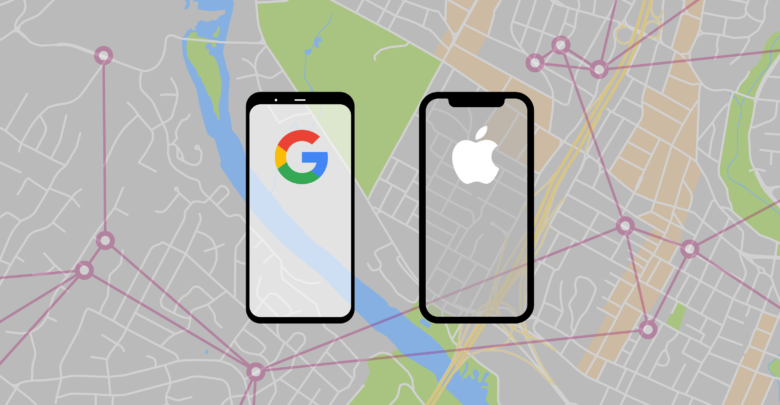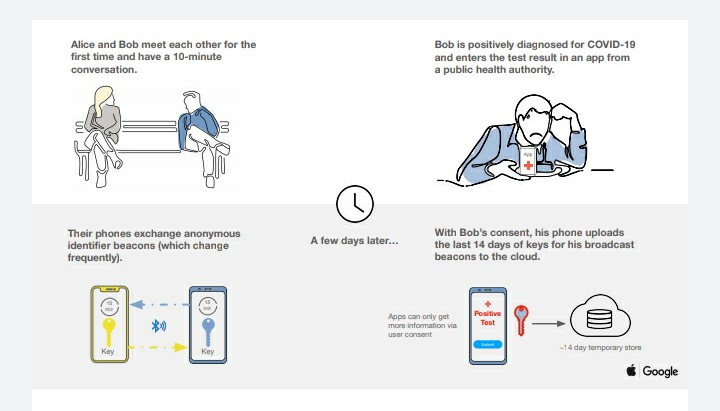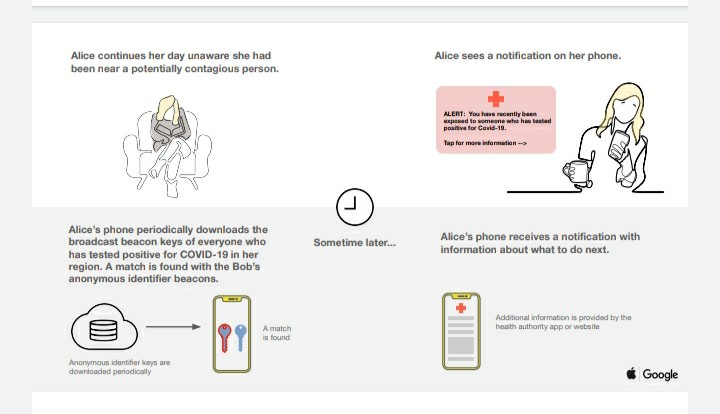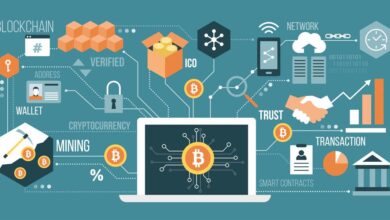Uncategorized
Coming together of the Tech Tycoons: Google-Apple collaboration

Google LLC and Apple Inc. have announced that they would be collaborating to fight COVID-19 pandemic by building a “Bluetooth-based COVID contact tracing platform” that will be notifying individuals whenever they come in contact with any coronavirus infected individual who also has the application downloaded on his cellphone. This collaboration will certainly be of much help to the health authorities in keeping a track of the spread of this pandemic without violating the user’s privacy.
CEO of Google, Mr Sundar Pichai has tweeted, “the two companies are committed to working together on these efforts”. Tim Cook, the CEO of Apple also tweeted that this new initiative made by the two companies will respect the consent and transparency of its users. In their joint statements the two CEOs have said that “Since COVID-19 can be transmitted through close proximity to affected individuals, public health officials have identified contact tracing as a valuable tool to help contain its spread. A number of leading public health authorities, universities, and NGOs around the world have been doing important work to develop opt-in contact tracing technology. To further this cause, Apple and Google will be launching a comprehensive solution that includes Application Programming Interfaces (APIs) and operating system-level technology to assist in enabling contact tracing. Given the urgent need, the plan is to implement this solution in two steps while maintaining strong protections around user privacy.”
The two tech giants are currently working on an operating system-level technology and Application Programming Interfaces (APIs) in order to assist the health workers and officials in enabling the contact tracing. These APIs would help and allow Android and iOS devices to exchange information, and would further notify the health workers to keep track of the spreading of this deadly disease. So, once this feature comes into operation, whenever any two individuals would be near each other (or come in contact with each other), their phones will be exchanging an identification key and the users will get notification whether they have come into contact with any COVID-19 infected person or not. This would enable the users to either self-quarantine or get themselves tested. Also, if the user contracts the COVID-19 virus, he can even notify the other person as well about it. The two companies have made sure that the privacy of their users is not breached and therefore, this application will be working without revealing the name of its users or any of their data. The person who got contracted with COVID-19 will just be notified that he came in contact with a COVID-19 infected person and nothing else. In fact, the location of the user will also not be traced by the devices.
Google and Apple have emphasized that they would not be gathering anybody’s exact directions or coordinates (or any data for the reason) for fighting the novel coronavirus. Rather, a gadget with a contact-tracing application would communicate a one of a kind signal at regular intervals to different gadgets close by, including those that draw near six feet, since six feet is the minimum range provided by the Centers for Disease Control and Prevention for social distancing.
The two tech giants also said in their joint statement to the media that, “in the coming months, Apple and Google will work to enable a broader Bluetooth-based contact tracing platform by building this functionality into the underlying platforms. This is a more robust solution than an API and would allow more individuals to participate if they choose to opt-in, as well as enable interaction with a broader ecosystem of apps and government health authorities. Privacy, transparency, and consent are of utmost importance in this effort, and we look forward to building this functionality in consultation with interested stakeholders. We will openly publish information about our work for others to analyze.”
With Apple and Google, the major challenge will be that it is altogether in the hands of its users because the framework is willful, it depends on individuals downloading and utilizing the application appropriately. To address worries about potential maltreatment, concerned users would need to get an affirmed analysis from any general health agency that they have contracted the coronavirus, alongside an exceptional code, for instance — that triggers the sign to different gadgets, as per Apple.
This initiative is going to be made in 2 stages. One month from now, both Google and Apple will release their APIs that will permit contact tracing through outsider applications released by health specialists. Users of the two Android and iOS gadgets can download this application through their individual application stores.
For the time being, it’s upon the will of the users to install and give the necessary permissions to these contact-tracing applications, which are still being worked on by foundations, for example, the Massachusetts Institute of Technology’s Private Automated Contact Tracing (PACT). Also, it would be totally dependent upon the person to show on the off chance that they had gotten the infection, bringing about unknown alarms being sent to the individuals who had been in that individual’s contact. Disease transmission specialists and general health officials have as of late focused on Bluetooth innovation as an imperative instrument for human groups looking to follow and stem the pandemic’s development. Designers said it would supplement human contact-tracing endeavors, in which general health officials will talk with individuals to discover who they reached the hour of their disease or came in contact with.
The Contact Tracing Bluetooth Specification which is being developed by Apple and Google together and is further subject to extension and modification will not be using the location of its users for proximity detection but is only restricted to Bluetooth beaconing. Rolling Proximity Identifiers of a user keeps on changing every 15 minutes and requires Daily Tracing Key to be related to its users which reduces its users’ risk of privacy loss and it totally depends on its users, to decide whether to contribute to contact tracing or not. The server will have the consent of the user to share their Diagnosis key if diagnosed with COVID-19. Rolling Proximity Identifier of a user cannot be correlated without having the Daily Tracing Key. Thus, reducing the risk of privacy loss. A server operator that will be implementing this protocol will not learn who their users have been in contact with or their location until and unless users report their Diagnosis Keys without which it will be difficult for an attacker to search for a collision on Rolling Proximity Identifier. This reporting will only be limited to 24hrs period. After the users have uploaded their Diagnosis Keys, the server must not be retaining any metadata of its users after including them into the aggregated list per day of its Diagnosis Keys.
The below-given picture presented by Apple and Google clearly portrays their idea and working of this application.


Ron Rivest, a famous cryptography expert and a PACT leader has already started some of the difficulties with such applications. It tends to be difficult to gauge go with Bluetooth and its results. Since such results will vary depending upon the manner in which the device is situated, regardless of whether it is tucked inside someone’s pocket or held against someone’s head for a call and the Bluetooth device apart from human beings also senses the walls, windows, and car doors, making it difficult to track the total number of COVID-19 infected persons. Since the device will just be notifying its users that they came in contact with a COVID infected. Jennifer Granick, a cybersecurity counsel and an ACLU surveillance, said that an individual will possibly believe in these frameworks on the off chance that they ensure security, stay deliberate, and store information on a person’s gadget and is not any centralized repository.
Privacy advocates see the utilization of Bluetooth innovation right now, both less intrusive and more valuable than different investigations utilizing cell phone area information that have surfaced as of late, as the pandemic has extended. While the users will have next to zero capacity to control the information gathered by application producers and telephone companies about their movements, they can either turn off their device’s Bluetooth or decline to download the proposed applications for coronavirus tracking.
While it’s a difficult task to keep track of an individuals’ movements for the duration of the day, it’s not precise enough to gauge if individuals are keeping a separation of six feet or not. GPS information can just help us to get down to an accuracy of around 5 to 20 meters, while a cell tower information gives only a general direction of travel or the location of an individual. Also in our country where most of the population does not have Android or iOS, tracking the health status of such people will become difficult for these companies and health officials.
In India currently, Aarogya Setu is a parallel app to the one which is being developed by the two companies based on the method used by them for tracking movements of everyone. Since there are no APIs currently, therefore interoperability between iOS and Android cannot be done. However, once the two tech giants implement their planned feature to fight this epidemic, things might be different for all of us, across the whole world.
The thought is that the area information would help government authorities know whether individuals are maintaining social distancing guidelines and give a background marked by who COVID-19 patients have been in contact with to reinforce isolating efforts. However, the new association between Google and Apple reflects a developing acknowledgment in Silicon Valley that mainstream tech giants and the troves of information they create can be put to new use in following the pandemic.





